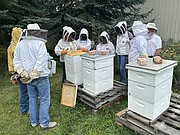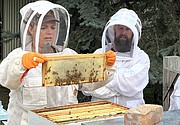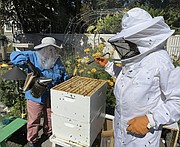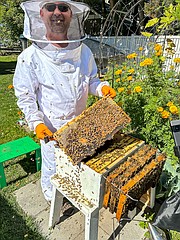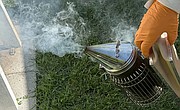Liquid gold — honey bees produce precious gift
Bees using canola produce honey that is colored a bright yellow, whereas bees flying into fields of weeds and wildflowers might produce honey that is light yellow. Flowers also influence the honey’s taste.
No matter the source of the nectar and how it changes the honey later poured into jars by beekeepers, the process begins with a group of remarkable insects — the honey bee.
The Flathead Valley has 270 registered beekeepers and as we enter fall many are now preparing to winterize their hives. There are about 650 registered beekeepers in Montana, according to the state Beekeeper Program under the state Department of Agriculture.
But before we explore the creation of honey we should understand more about a gifted lady often buried in groups that may cluster into swarms numbering in the thousands. But despite the huddle, every single bee in the group gears its life toward the betterment of this one special individual, the Queen Bee. Assistance comes from her workers and her drones, and their functions are vital not only to the queen but for the necessary production of all that delicious honey.
Drones fertilize the queen, but when they do they lose their sex organ — and then they die. But what happens if the Queen Bee dies? In short, a queenless colony cannot survive long, for she lays eggs, and the hormone she releases affects the attitude of the worker bees. Workers respond by finding the best larvae and then housing them in specially designed queen cells, where they feed on a special form of jelly. This food initiates rapid growth soon resulting in pupation. A week later our unsullied queen embarks on a nuptial flight, at which time she mates with many fatalistic drones. Then our covetous queen hastens to kill any other virgin queens still in the hive.
MOST OF this information I acquired from my son and his wife, who developed a passion for beekeeping after attending a popular course taught by Angela Tollerson, designated by the University of Montana as a Master Beekeeper class. Obsession with the subject brings David and Chelynne, and all other members of the Flathead Valley Beekeepers, into close contact with their charges. To protect themselves they wear specialized clothing. Occasionally, however, they still get stung, but when they do they usually wax philosophical.
“Just part of the game,” they grin. “It feels like a small burn, but doesn’t last long. As you can see, there is only a small swelling.”
Despite the complacency of some of Tollerson’s shirt-sleeved “students,” all were completely garbed when they attended the season’s final meeting of the beekeepers club, held in September at a member’s farm. The purpose of the gathering was for Tollerson to demonstrate the proper procedure for winterizing bee hives.
Angela began her demonstration, asking if anyone might have a guess concerning the weight of a hive. Guesses varied but Tollerson resolved the matter saying that hive weight varies throughout the year ranging from 40 to 100 pounds.
“Right now, the hive weighs about 70 pounds, and most of that weight comes from the water in the nectar bees collect,” she said.
WHEN A bee collects nectar it goes straight from the flower and is exuded into a honey bee’s second stomach, where it mixes with sugar. Back in the hives, bees deposit this combination into cells and begin a vigorous process of fluttering their wings in an attempt to blow off excess water in the nectar. When they sense job completion, they cap the cells with beeswax produced from a wax gland also found in their stomachs.
Many such honey cells are created and bees will later use the contents for winter feed but rarely eat it all. Excess honey is what beekeepers harvest, although extraction can be laborious.
Honey is often gathered during the winterization period, and one very efficient technique of extracting honey is to remove each frame from the hive. Separately at that time, caps are carefully cut from each cell. Frames are then placed into a bucket or extractor. You’d then attach a properly equipped drill designed to spin the frame. Centrifugal force throws honey from each cell onto the bucket’s side. Later, it can be poured from the bucket into jars and containers.
When jars are examined the variations in the color of the honey can be observed.
At the end of the flower season and before winter, hives must be winterized. Going through a cleaning process is necessary because bees do not hibernate. Rather, they stay in the hive all winter, keeping it warm and eating the honey they produce during the summer. Clusters of honey bees move around the hive, which in turn warms the hive.
Moisture remains an important concern in the winterization process, for bees inside the hive exude a vapor that has been exhaled from their lungs. Subsequently, it is important to ensure that ventilation and warmth inside the hive are adequate, and so winterization for some means engulfing the outside of the hives with polystyrene foam padding.
“Come winter,” added David and Cheylenne. “We can check the condition of our bees by simply tapping on the outside of the hive. If the tapping produces a buzzing sound inside, we’ll know the queen and all helpers are OK.”
BEES IN recent years have experienced a vast decline. Factors contributing to the decline include habitat loss, improper apiary management, climate change and pesticides. Wildlife can also undermine the population of bees in a hive, and several farmers, whose hives have been trashed by hungry bears hoping for easy access to honey. The problem is mitigated by surrounding hives with an electric fence, whereby many Montana apiaries successfully continue the complex process of creating very tasty honey.
Montana’s beekeepers, however, have not declined in number. Montana typically ranks in the top five states in the U.S. for honey production. The state’s high yields are also the result of its long summer days and the diverse landscape consisting of flowering crops and wildflowers, according to beekeeping instructor Tollerson.
Montana hives last year produced 7.5 million pounds of honey, which was up 13 percent from the previous year, according to the U.S. Department of Agriculture. There were 123,000 colonies producing honey last year.
Interestingly, my son and his wife extracted 30 pounds in their first year from a guestimated collection of 30,000 workers and drones and their most important charge — the one queen bee. Its presence provides an assurance that at season’s end, some might find an absolutely delicious honey.








